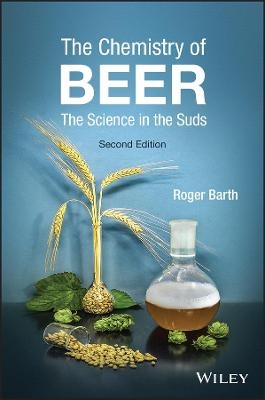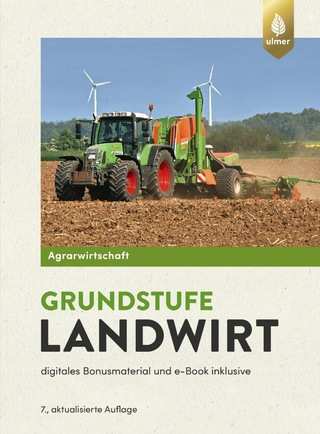
The Chemistry of Beer
John Wiley & Sons Inc (Verlag)
978-1-119-78333-6 (ISBN)
From the earliest civilizations to our own day, brewing beer has driven science and technology. In ancient times, brewing was the most advanced biotechnical process. In the modern world, the study of alcoholic fermentation was the springboard for the new science of biochemistry. The Chemistry of Beer: The Science in the Suds, 2nd Edition explains the scientific basis of each brewing step as we understand it today.
Readers of this second edition will find:
Updates and revisions include a new chapter on beer-related products such as hard seltzer, flavored malt beverages, and non-alcoholic beer
Streamlined language and structure to help clarify the chemistry
Over 200 illustrations, now in full color throughout
Complete glossary and index
Question sets at the end of each chapter to check for understanding
Online solutions manual on a companion website for professors
The Chemistry of Beer: The Science in the Suds, 2nd Edition is designed to engage students in an introductory chemistry course. Optional material extends the level to make it a useful supplement for a brewing science course. The material and style of presentation will interest brewing professionals, others in the beverage industry, advanced homebrewers, and beer enthusiasts.
Roger Barth, PhD, is professor emeritus at West Chester University. He is the creator of a course on the chemistry of beer and coauthor of Mastering Brewing Science: Quality and Production (Wiley, 2019).
Preface to the Second Edition vii
Reading Notes viii
Acknowledgments viii
About the Author ix
1 Introduction 1
Chapter 1 Overview 1
Brief History 1
The World of Beer 11
Beer and Technology 14
Beer and Chemistry 18
Alcohol and Prohibition 23
Beer Tradition 25
Chapter 1 Highlights 27
Chapter 1 Sources 27
Chapter 1 Questions 30
2 What is Beer? 33
Chapter 2 Overview 33
Beer Composition 33
Beer Ingredients 33
Beer as Food 37
How Beer is Made 39
Chapter 2 Highlights 46
Chapter 2 Sources 47
Chapter 2 Questions 47
3 Chemistry Basics 51
Chapter 3 Overview 51
Atoms 51
Compounds 54
Names of Chemical Compounds 60
Molecular Shape 62
Polarity and Electronegativity 65
Intermolecular Forces 67
Molecular Kinetics 70
Chemical Reactions and Equations 71
Oxidation Numbers 72
Amount of Substance (Moles) 74
Mixtures 75
Composition of Mixtures 75
Mass Relationships in Compounds 77
Chapter 3 Highlights 78
Chapter 3 Sources 79
Chapter 3 Questions 79
4 Water 85
Chapter 4 Overview 85
The Water Molecule 85
Acids and Bases 87
pH 89
pH—A Closer Look 91
Ions and Beer 92
Measuring Alkalinity 93
Measuring Hardness 93
Water Treatment 97
Osmosis—A Closer Look 98
Hydrates—A Closer Look 102
Chapter 4 Highlights 103
Chapter 4 Sources 103
Chapter 4 Questions 104
5 Introduction to Organic Chemistry 107
Chapter 5 Overview 107
Structural Formulas 107
Functional Groups 109
Using the Functional Group Guide 120
Naming Organic Compounds 121
Chapter 5 Highlights 123
Chapter 5 Sources 124
Chapter 5 Questions 124
6 Carbohydrates 129
Chapter 6 Overview 129
Monosaccharides 129
Chirality 131
Absolute Configurations—A Closer Look 132
Disaccharides 136
Polysaccharides 137
Know Your Carbohydrates 140
Testing Carbohydrates 141
Chapter 6 Highlights 141
Chapter 6 Source 142
Chapter 6 Questions 142
7 Milling and Mashing 145
Chapter 7 Overview 145
Milling 145
Mashing 146
Enzymes and Proteins 149
Amylase Mechanism 155
Mashing Process 156
Dextrins, Light Beer, and Malt Liquor 159
Chapter 7 Highlights 159
Chapter 7 Sources 160
Chapter 7 Questions 160
8 Wort Separation and Boiling 163
Chapter 8 Overview 163
Wort Separation 163
Boiling 166
Hops 167
Chilling 172
Chapter 8 Highlights 173
Chapter 8 Sources 174
Chapter 8 Questions 174
9 Fermentation 177
Chapter 9 Overview 177
Energy and Bonds 177
Energy from ATP 179
Glycolysis 180
Ethanol Synthesis 182
Aerobic and Anaerobic Reactions 185
Flavor Compounds 186
Chapter 9 Highlights 188
Chapter 9 Sources 188
Chapter 9 Questions 189
10 Tests and Measurements 193
Chapter 10 Overview 193
Measurement in Chemistry 193
Brewing Measurements 197
Carbohydrate Calculations 200
Temperature 201
Color 204
Light and Color—A Closer Look 204
Alcohol Concentration 205
pH 208
Carbonation 210
Sensory Analysis 210
Chapter 10 Highlights 211
Chapter 10 Sources 211
Chapter 10 Questions 212
11 The Chemistry of Flavor and Style 215
Chapter 11 Overview 215
Flavor 215
Flavor Compounds 221
Off-Flavors 232
Brewing Water and Flavor 236
Beer Styles 236
Chapter 11 Highlights 240
Chapter 11 Sources 241
Chapter 11 Questions 242
12 Beer-Related Products 245
Chapter 12 Overview 245
Non-Alcohol/Low Alcohol Beer 245
Cider 251
Flavored Malt Beverages 252
Hard Seltzer 252
Mead 252
Sake 253
Kombucha 254
Vinegar 254
Chapter 12 Highlights 255
Chapter 12 Sources 256
Chapter 12 Questions 257
13 Haze and Foam 259
Chapter 13 Overview 259
Surfaces 259
Surfactants 261
Haze 261
Foam 265
Gases–A Closer Look 265
Gases and Liquids 268
Foam Issues 273
Nitrogen and Widgets 273
Chapter 13 Highlights 275
Chapter 13 Sources 275
Chapter 13 Questions 276
14 Beer Flavor Stability and Packaging 279
Chapter 14 Overview 279
Typical Flavor Changes 279
The Role of Oxygen 280
Staling Prevention 283
Beer Packaging 285
Bottling and Canning 289
Microbe Reduction 290
Chapter 14 Highlights 290
Chapter 14 Sources 291
Chapter 14 Questions 292
15 Brewing at Home and as a Career 295
Chapter 15 Overview 295
Homebrewing Methods 295
Safety Issues 296
Cleaning and Sanitation 297
About Yeast 298
Full Mash Brewing 298
Extract Brewing 310
Bottling 311
Using Liquid Yeast 315
Getting Started Cheap 316
Brewing Lager Beer 317
Brewing as a Career 318
Chapter 15 Highlights 319
Chapter 15 Sources 320
Chapter 15 Questions 321
Glossary 323
Index 357
| Erscheinungsdatum | 13.08.2022 |
|---|---|
| Verlagsort | New York |
| Sprache | englisch |
| Maße | 150 x 226 mm |
| Gewicht | 590 g |
| Themenwelt | Technik |
| Weitere Fachgebiete ► Land- / Forstwirtschaft / Fischerei | |
| ISBN-10 | 1-119-78333-X / 111978333X |
| ISBN-13 | 978-1-119-78333-6 / 9781119783336 |
| Zustand | Neuware |
| Informationen gemäß Produktsicherheitsverordnung (GPSR) | |
| Haben Sie eine Frage zum Produkt? |
aus dem Bereich


